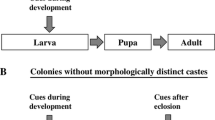Abstract
Caste determination in primitively eusocial sweat bees is thought to be due to an interacting suite of factors, including size of the larval provision mass, time of year, and social context of the nest into which a young female emerges. Newly emerged gynes are significantly fatter than newly emerged workers, suggesting the existence of larval caste determination cues. Since photoperiod, temperature, and interactions with nestmates were unlikely to affect larval caste determination, we compared the sizes and contents of larval provision masses destined to produce either workers or gynes. Gyne-destined larvae consumed pollen masses that were larger and contained slightly more sugar than those of worker-destined larvae. We suggest that sugar content is one cue which prompts the development of fat reserves in gyne-destined females but not in worker-destined females. The amount of fat possessed by a newly emerged female influences her chances of successfully entering diapause shortly after emergence. Therefore, small, lean females may be more susceptible to behavioural control by queens and more likely to become workers, while large, fat females would be more likely to become gynes.
Similar content being viewed by others
References
Asencot M, Lensky Y (1976) The effect of sugars and juvenile hormone on the differentiation of the female honeybee larvae (Apis mellifera L.) to queens. Life Sci 18:693–700
Baker HG, Baker I (1973) Amino acids in nectar and their evolutionary significance. Nature 241:543–545
Baker HG, Baker I (1975) Studies of nectar-constitution and pollinator-plant coevolution. In: Gilbert LE, Raven PH (eds) Coevolution of plants and animals. University of Texas Press, Austin, pp 243–264
Boomsma JJ, Eickwort GC (1993) Colony structure, provisioning and sex allocation in the sweat bee Halictus ligatus (Hymenoptera: Halictidae). Biol J Linn Soc 48:355–377
Chandler L (1955) The ecological life history of Halictus (H.) ligatus Say with notes on related species. PhD thesis, Purdue University, Michigan
Dafni A (1992) Pollination ecology, a practical approach. Oxford University Press, Oxford
Gadagkar R, Bhagavan S, Chandrashekara K, Vinutha C (1991) The role of larval nutrition in pre-imaginal biasing of caste in the primitively eusocial wasp Ropalidia marginata (Hymenoptera: Vespidae). Ecol Entomol 16:435–440
Hartfelder K (1990) Regulatory steps in caste development of eusocial bees. In: Engels W (ed) Social insects: an evolutionary approach to castes and reproduction. Springer, Berlin Heidelberg New York, pp 245–264
Hunt JM (1991) Nourishment and the evolution of the social Vespidae. In: Ross KG, Matthews RW (eds) The social biology of wasps. Comstock, Ithaca, NY, pp 426–450
Knerer G (1980) Biologic und Sozialverhalten von Bienenarten der Gattung Halictus Latreille (Hymenoptera, Halictidae). Zool Jahrb Syst 107:511–536
Kukuk PF, May B (1991) Colony dynamics in a primitively eusocial halictine bee Lasioglossum (Dialictus) zephyrum (Hymenoptera: Halictidae). Insectes Soc 38:171–189
Litte M (1977) Aspects of the social biology of the bee Halictus ligatus in New York State (Hymenoptera; Halictidae). Insectes Soc 24:9–36
Michener CD (1974) The social behavior of the bees. Harvard University Press, Cambridge
Michener CD (1990) Reproduction and castes in social halictine bees. In: Engels W (ed) Social insects: an evolutionary approach to castes and reproduction. Springer, Berlin Heidelberg New York, pp 77–121
Michener CD, Bennett FD (1977) Geographical variation in nesting biology and social organization of Halictus ligatus. Univ Kansas Sci Bull 51:233–260
Packer L (1986a) The social organisation of Halictus ligatus (Hymenoptera; Halictidae) in southern Ontario. Can J Zool 64:2317–2324
Packer L (1986b) Multiple foundress associations in a temperate population of Halictus ligatus. Can J Zool 64:2325–2332
Packer L (1988) The effect of Bombylius pulchellus (Diptera; Bombyliidae) and other mortality factors upon the biology of Halictus ligatus (Hymenoptera; Halictidae) in southern Ontario. Can J Zool 66:611–616
Packer L, Knerer G (1986a) The biology of a subtropical population of Halictus ligatus I. Phenology and social organisation. Behav Ecol Sociobiol 18:363–375
Packer L, Knerer G (1986b) An analysis of variation in the nest architecture of Halictus ligatus in Ontario. Insectes Soc 33:190–204
Plateaux-Quénu C (1960) Nouvelle preuve d'un déterminisme imaginal des castes chez Halictus marginatus Brullé. C R Acad Sci Paris 250:4465–4466
Plateaux-Quénu C (1983) Le volume d'un pain d'abeille influence-til le sexe de l'oeuf pondu sur lui? Etude expérimentale, portant sur la premiere couvée d'Evylaeus calceatus (Scop.) Ann Sci Nat Zool (13) 5:41–52
Richards MH (1994) Social responses to changing environments: reproductive behaviour and reproductive options in a primitively eusocial sweat bee. PhD thesis, York University, North York, Ontario
Wheeler DE (1986) Developmental and physiological determinants of caste in social Hymenoptera: evolutionary implications. Am Nat 128:13–34
Wilde J de (1976) Juvenile hormone and caste differentiation in the honey bee (Apis mellifera L.). In: Luscher M (ed) Phase and caste determination in insects: endocrine aspects. Pergamon Press, Oxford, pp 5–20
Wilde J de, Beetsma J (1982) The physiology of caste development in social insects. Adv Insect Physiol 16:167–244
Wirtz P (1973) Differentiation in the honeybee larva. Meded Landbouwhogesch Wageningen 75:1–66
Yanega D (1989) Caste determination and differential diapause within the first brood of Halictus rubicundus in New York (Hymenoptera: Halictidae). Behav Ecol Sociobiol 24:97–107
Author information
Authors and Affiliations
Additional information
Correspondence to: M.H. Richards
Rights and permissions
About this article
Cite this article
Richards, M.H., Packer, L. Trophic aspects of caste determination in Halictus ligatus, a primitively eusocial sweat bee. Behav Ecol Sociobiol 34, 385–391 (1994). https://doi.org/10.1007/BF00167329
Received:
Accepted:
Issue Date:
DOI: https://doi.org/10.1007/BF00167329




